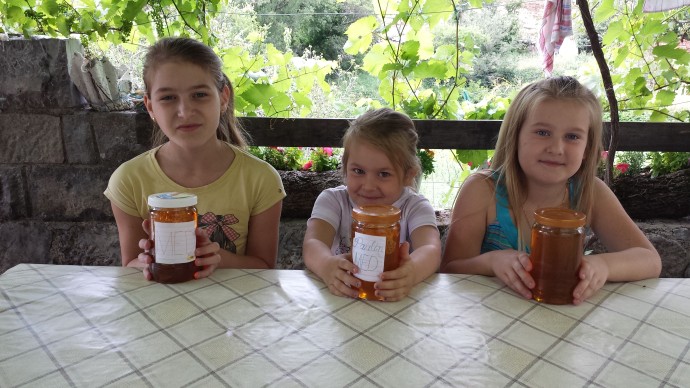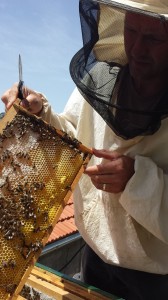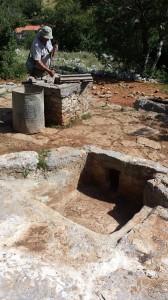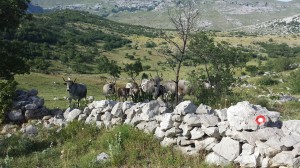I went for a walk along the old hiking trail towards Modrić. Walking along the periphery of the main pasture and into a part of the trail that was thick with wildflowers and grasses until I could no longer see the trail.

At this point in the trail, the magnitude of wildflower and insect diversity was most noticeable and remarkable. Insects were buzzing in the grass and in the air, from sun-loving and shade-loving flies to a wide assortment of curious pollinators and heavy or colorful beetles – they were everywhere! It was wonderful!

I talked to Petar and Marijana about the bee hives they managed. Given the mixed nature of the local pollen and nectar sources, the honey comes from any number of wildflowers including the medicinal plants Thymus serpyllum (common name: majčina dušica or vrisak) and Hypericum perforatum (common name: Gospina trava). Depending on wildflower abundance and beehive productivity, honey harvest may be a useful financial supplement for the farm. Petar explained and showed that once two thirds of a frame is covered in wax, the honey is ready to harvest. At that time, the combs are drained of this delicious honey. It is sold or gifted in jars (sing. tegla) which the girls claimed and exhibited.
Later we spoke about the water resource management. Water is the most important limited resource in the area since the nearest natural spring is approximately 3 km away; it is also unreliable in winter as it tends to freeze. In the summer, water is considered more important than food for the livestock. Rain collected from their stable rooftop is stored in containers with a capacity of 2 kubika (1 kubik = 1 m3 = 1,000 liters); within the stable itself is a storage unit with a capacity of 6 kubika; a stone reservoir (gusterna) that is furthest from the house and is replenished by rain has a capacity of 25 kubika. In case of insufficient rain, water must be brought from elsewhere. Therefore, maintaining a steady water supply and a two-month reserve in case of drought or inclement weather is a constant consideration. Constructing another gusterna with a capacity of 100 kubika would be ideal, but requires considerable time, work and money.
By the third day I had a pretty good sense of the routine on the farm. Petar, Marijana, and Petar’s parents would get up before dawn to work. Petar’s parents would take the goats out to pasture around 5 a.m. and would return about three hours later. In the meantime, Petar and Marijana might have been in the garden picking tomatoes, peas, or other vegetables, collecting honey from the bees or eggs from the chickens, milking a cow, cleaning the stable, making sure the livestock were all accounted for, or checking that there was enough water or hay, and so forth. Marijana would spend time with the girls or make delectable snacks and desserts between meals. The house was stocked with homemade cheese, bread, wine, a type of pork rind (pl. čvarci), prosciutto (pršut), among other things. Pršut is a specialty in Dalmatia on account of the bura, which is used to cure the meat over a period of months.

Petar was always on the move. Even his breakfast was interrupted by a call about the loads of supplementary hay he ordered for today. The remote destination and the long, steep, rocky road up the mountain are deterrents to some sellers and often lead to delays and higher prices than for buyers at sea level. Therefore, getting anything brought up from sea level takes preparation, time, and money as well as grit and will of those driving across the rough and rocky terrain.
As I observed the Boškarin at the stable in the morning and in the main pasture that evening, I noted behaviors as well as each individual’s distinguishing physical characteristics. I could more easily recognize them by name, though I still knew far less about their personalities and traits than Petar, who spent the most time with them. He generously gave me pointers on the Boškarin – especially horn characteristics – and imparted his knowledge of them, including their history and routine. By this point, I was less intimidated by their size (the tallest at the shoulder was a 152 cm female named Formina) and they appeared to be more accustomed to me.
I took a long walk along the road that afternoon, wanting to catch a more expansive glimpse of the sea. I walked until the heat harried me back but not before I reached the top of a hill where I could see the full horizon of the stunning expanse of land and sea kilometers away. By the time I returned to the house the first truck-load of hay arrived and was already unloaded; Petar and the men who transported the hay were heading back for the second load.

The girls were usually painting pictures, drawing, making rockets and airplanes, or paper frogs, puppies and kittens. They engaged me with games and walks when I had little else to do. This evening, as the goats were herded back from their evening grazing, I spent some time with the girls showing them photos I took of their home and the Boškarin. Marijana was busy in the kitchen and had heard from Petar that he would be returning for dinner around 10 p.m. with the second hay load. By the time we were half way through with dinner and the food had cooled, Petar and a friend strolled down the dark road to the house, flashlights in hand. They had been dealing with the hay all day but had not been able to bring the second load to the house; it was to be unloaded early the next morning.
It was clear how extremely well Petar and his friend knew the mountains. Petar had been to Sveto Brdo numerous times and had walked for kilometers not needing the trail blazes. Indeed, it is people like him who help the hiking communities designate hiking trails. His friend was a neighbor who lives kilometers away and who was helping him. So it would seem that this is how it’s done – neighbors and relatives helping each other and sharing resources. The work ethic is not bound by 9-to-5 because the work is constant, relentless, driven by need imposed by the land as well as a deep-rooted passion for the land, lifestyle, and family.
Acknowledgements: I want to thank the Knežević family for their generosity, hospitality, great conversations, honey, wine and delicious food. I am grateful to Davor Krmpotić for his time, support, encouragement, devotion to the work on Velebit and for arranging the visit to the Knežević family home, and to the Rewilding Europe community for making the volunteering experience possible. It was a pleasure to spend time with the people I met and to work with the Boškarin.
Rewilding Europe note: The Boškarin cattle here are a part of the Tauros project, an initiative by the Taurus Foundation, supported by Rewilding Europe, with the ambition to backbreed a functional, wild version of the aurochs, which went extinct as a wild animal in 1627. Since all the aurochs DNA is still alive, but now spread out over a number of ancient cattle breeds, the idea is to try to bring it back. The Boškarin is one of those ancient breeds that carry important parts of the aurochs DNA. This is a process in several steps and Petar’s farmstead represents one of the first, to create a breeding stock of animals that are slowly becoming more and more used to life in the wild. These will later be crossed with animals from some of other cattle breeds that are close to the aurochs, like Sayaguesas from Spain or Maremmanas from Italy.
Read also Being a volunteer in the Velebit rewilding area – part I
